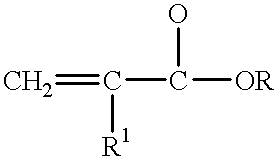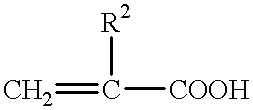Weatherable building products
a building product and weatherproof technology, applied in the field of weatherproof building products, can solve the problems of affecting the use efficiency of building products formed of wood members, affecting the use efficiency of building products, etc., to achieve the effect of reducing material usage costs, eliminating porosity, and eliminating accumulated volatiles
- Summary
- Abstract
- Description
- Claims
- Application Information
AI Technical Summary
Benefits of technology
Problems solved by technology
Method used
Image
Examples
second embodiment
In a second embodiment, the weatherability coating composition comprises a polyurethane or acrylic-urethane hybrid polymers coating composition. Preferably, the polyurethane or acrylic-urethane hybrid polymers have number averaged molecular weight greater than 100,000. The coating composition based on polyurethane or acrylic-urethane hybrid polymers may be doped with various ultraviolet protection packages known in the art, as well as fungicides. The coating composition based on polyurethane or acrylic-urethane hybrid polymers have also been found to provide a limited and uniform surface porosity which permits enhanced staining and painting of the finished products, especially at lower densities of the products.
Application of either coating composition of the second embodiment to the product in one step may be accomplished by a brush or other device having relatively low shear during application such as a curtain coater, a flow coater, immersion, or a roller.
By low shear we mean a s...
example 5
The second embodiment of the present invention may be directed to a door assembly having an inserted full partial core or a core formed in-situ positioned within a frame. A pair of opposed molded skins with downstanding ribs made by the present invention are attached to the frame, which may also be made by the present invention. There are edges adjacent the skin. The skins are made of a composite board of filled novolac phenolic resin prepared within 15 to 25 weight percent novolac. The filler is a kiln-dried soft-wood wood flour derived from kiln-dried lumber, veneers of various thicknesses, flakes, chips, excelsior, strands, wood particles or wood fiber bundles. High lignin content wood flours work best because lignin is the most subject to acid hydrolysis in reacting with the phenolic resins. The ranking is lignin, hemicellulose and cellulose. In reported reactions, the wood acidity is neutralized by reaction with sufficient quantities of phenolic resins.
Comminuted paper products...
example 6
The second embodiment of the present invention may be directed to exterior trim and siding for residential housing having a single profile produced by an extrusion process possibly accompanying by a rotary shaping mold or vacuum sizing flanges with slots for expansion and contraction with heat and humidity. The flanges are lapped by the adjacent piece of siding. The material contains 15 to 40 weight percent phenolic resin. The upper limit is determined by the design allowances for linear thermal and humidity expansion. The linear humidity expansion coefficients varies with the thickness of a redundant seal coat, as well as the fraction of resin present. The water based acrylic-polyurethane hybrid polymer seal coat such as Air Products 620 or Sancure.TM. AU4010 of BF Goodrich (Brecksville, Ohio) resin is doped with 0.25 to 1.0 weight percent of a water miscible fungicide such as Polyphase P20T by Troysan to cover all exposed exterior surfaces. The thermal expansion coefficients is do...
PUM
| Property | Measurement | Unit |
|---|---|---|
| Percent by mass | aaaaa | aaaaa |
| Percent by mass | aaaaa | aaaaa |
| Percent by mass | aaaaa | aaaaa |
Abstract
Description
Claims
Application Information
 Login to View More
Login to View More - R&D
- Intellectual Property
- Life Sciences
- Materials
- Tech Scout
- Unparalleled Data Quality
- Higher Quality Content
- 60% Fewer Hallucinations
Browse by: Latest US Patents, China's latest patents, Technical Efficacy Thesaurus, Application Domain, Technology Topic, Popular Technical Reports.
© 2025 PatSnap. All rights reserved.Legal|Privacy policy|Modern Slavery Act Transparency Statement|Sitemap|About US| Contact US: help@patsnap.com



